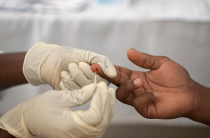Alas, modern medicine has not found a way to cure humanity of allergies. The safest and most effective method is to eliminate contact with allergens. Without a constant supply of allergy-provoking factors to the body, it is impossible to develop an allergic reaction. But first of all, you need to know what component of the environment you are allergic to. Without knowledge of the allergen, it is simply impossible to conduct effective barrier therapy.
Suspicions of the patient, in this case, also play a significant role, on their basis, the expected scope of the search is narrowed, which makes it easier to carry out diagnostic measures that are aimed at identifying allergen-provoking factors as soon as possible.
Allergen tests are used with a wide range of diagnostic tools. For example, tests are often used that involve direct contact of the patient with allergens (skin tests and provocative tests), which are not carried out in pediatric practice, due to the weakness of the child's body, which is completely undesirable contact with the allergen. While adults tolerate such tests much easier.
Before testing for allergens, the doctor carefully listens to the patient's complaints, learns about concomitant diseases and methods of their therapy. It is necessary to conduct a complete and comprehensive survey of the patient about everything related to his lifestyle and other things that are significant from the point of view of diagnosis.
Allergy symptoms
Although symptom testing is not an allergen test per se, it is a critical diagnostic measure. The appearance of allergy symptoms has a clear relationship with the penetration of the allergen. So, a patient with a food allergy notes an allergy only after a certain product enters the body, which is an allergen for him, etc. Allergy symptoms are characterized by:
- Skin manifestations of an allergic reaction. This symptom of allergy cannot be confused with anything: the skin of the patient, in the places of localization of the allergic reaction, becomes red, covered with blisters filled with liquid contents, which, when pressed, can become covered with a crust. Places of manifestations of an allergic reaction are often itchy and flaky, there may be irritation.
- Allergic rhinitis is a group of allergic manifestations that affect the nasopharynx. It is characterized by constant sneezing, secretion of a transparent secret from the nasal sinuses, nasal congestion, drying of the mucous membranes of the nasal sinus;
- Allergic conjunctivitis is an extensive symptomatology that affects the patient's organs of vision. It is characterized by: increased lacrimation, redness of the eyes, the formation of a conjunctive crust, irritation, vasodilation in the eyes, pain, a feeling of a foreign body.
During an allergy, the patient may also notice asthmatic manifestations, in this case they speak of asthma of an allergic nature. In addition, there is a general deterioration in well-being: nausea, weakness, irritability, fever.
Allergen tests
To date, there are quite a lot of high-precision methods for diagnosing not only the presence of an allergy, as such, but also the identification of a specific allergen. This is extremely in demand in a situation where the exact cause of an allergic reaction remains unknown. In principle, as such, any substance can be an allergen, but often in adults, these are:
- Certain food components, in this case, we are talking about food allergies;
- Pollen - this type of allergy is called polynosis. For her, the most characteristic symptoms are: sneezing, runny nose, headache, nasal congestion.
- House dust. As such, the dust has no allergenic potential. Allergic reactions are caused by the smallest mites that live on the surface of dust particles and, penetrating into the human body, provoke allergic reactions.
- Medications;
- Products of industrial production;
- The poison of stinging insects. Allergy to the poison of insects such as bees, wasps, hornets, bumblebees is especially dangerous. Patients sensitive to their stings are often prone to severe allergic symptoms, including anaphylactic shock and angioedema.
This is the most common list of allergens that cause most allergic reactions. This list is not exhaustive, but rather accurately characterizes the main instigators of allergies.
Complete blood count in adults
For allergies, both in adults and in children, the first thing to do is use a complete blood count. This is an important analysis that allows you to diagnose the general well-being of the body. Blood, performing a transport function, is in contact with all organs and organ systems. Her examination allows you to collect information about all organs or systems. In a general blood test, for allergies in adults, pay attention to the concentration of eosinophils in the blood. Eosinophils are blood cells that are responsible for the production of antibodies in the human body. Antibodies are part of our immune system and are proteins that, when combined with an allergen, provoke the development of allergy symptoms.
Blood test (total antibodies)
Common antibodies are proteins that increase with the development of allergic reactions, but do not serve as a specific factor for any type of allergy. The level of total antibodies, with an increase, only indicates that an allergic reaction is occurring. When testing for antibodies in adults, it must be taken into account that this level may differ from that in children and adolescents.
In some cases, the presence of an allergic reaction is not accompanied by a noticeable jump in the level of total antibodies. If there is a strong reason to believe that we are talking about allergies, then additional tests for special antibodies are necessary.
Blood test (special antibodies)
Special antibodies are special proteins in our body that are responsible for the development of reactions that occur after the acute response stage and last longer (from 6 hours to several days or more). Thanks to this analysis, it is possible to determine which type of allergen caused negative manifestations of allergic symptoms in a person (plant pollen, animal hair, helminths, etc.).
Benefits of a blood test:
- This method is carried out in vitro (that is, in vitro). This means that the reaction of the blood is checked in the laboratory and there is no need for direct contact of the patient with the allergen.
- There is no need to interrupt drug therapy;
- These tests can be performed not only in adults, but also in children and the elderly;
- Often a painless event that does not cause severe discomfort;
Skin testing in adults
As the name implies, skin testing is a diagnostic method that involves applying an allergen to an area of the skin in order to monitor the reaction.
When this substance is confirmed as an allergen, the patient's skin at the point of contact is transformed, a small blister appears, swelling and redness form. If this reaction is absent, then the alleged allergen is excluded. There are several ways to perform skin tests: with an injection, placing the allergen in the incisions, and applying a special bandage that contains the allergen. With skin tests, the following is excluded:
- Taking antihistamines, corticosteroids, and other substances that help relieve allergy symptoms;
- Physical activity two hours before the event.
- Not carried out among young children, as well as the elderly and pregnant women;
- Not carried out during the period of exacerbation;
The disadvantage of skin tests is that they do not detect food allergens.
In some cases, skin tests do not give the desired result, but at the same time, there is a strong suspicion of certain allergens. In this case, so-called provocative tests are carried out. This method consists in applying an allergen solution to the mucous membranes of the eyes or mouth. This method is more informative, but also more dangerous in terms of the development of complications.
Skin tests involve direct contact of the patient with the causative agents of an allergic reaction, therefore, should be carried out exclusively under the supervision of a qualified specialist.















